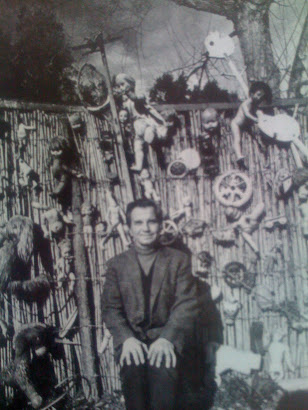
Pavel Zoubok Gallery presenta una mostra su lavori realizzati con tecniche e materiali misti e disegni dell’artista SALVATORE MEO (Philadelphia 1914- Roma 2004).
La galleria è lieta di accogliere i suoi visitatori al vernissage che si terrà giovedì 13 novembre dalle 16 alle 18 e durante tutta la durata della mostra.
L’indirizzo della galleria è: 533 West 23rd Street (tra 10th & 11th Avenues)
Orario di apertura: dal martedì al sabato dalle 10 alle 18.
Salvatore Meo, iconoclasta e innovatore, considerato un pioniere dell’assemblaggio, durante la sua carriera lunga quasi cinquant’anni, ha accorpato costantemente oggetti trovati, con un interesse particolare per il disegno e l’astrazione gestuale. E’stato uno dei primi artisti americani ad usare materiali provenienti dalla natura e scarti prodotti dall’uomo: oggetti rotti e/o abbandonati recuperati dalla strada, cassetti di mobilio, vecchi giocattoli, vestiti, pacchetti, ferri dei pattini, ossa, corde e fili, ferri arrugginiti. Si pone come precursore del rinnovato interesse per il Dada durante gli anni 50’ al quale contribuì la pubblicazione di Robert Motherwell “The Dada Painters and Poets (1951)” e l’installazione dell’Arensberg Collection al Philadelphia Museum of Art.
Meo non era interessato alla trasformazione alchemica dell’ordinario, la sua era un’esplorazione poetica dell’abbandono, del deperimento e della distruzione. Contrariamente ai suoi contemporanei Pop e Nouveau Realist quali Robert Rauschenberg e Mimmo Rotella, rifiuta il linguaggio seducente del mondo commerciale. I suoi impianti riverberano con una malinconia e un senso dell'alienazione che riflettono non solo il suo straniamento dalla corrente principale culturale, ma la sua empatia profonda per gli espropriati, siano essi oggetti o la gente. In questo senso, il suo lavoro trova una maggior affinità con le figure contemporanee quali Jannis Kounellis e David Hammons. Malgrado il suo ruolo attivo all'interno della comunità artistica italiana e l’acclamazione iniziale negli Stati Uniti e all'estero, Meo rimase sempre nascosto.
Nato nel sud di Philadelphia nel 1914 da genitori italiani, studiò presso la University of the Arts, la Tyler School of Art e the Barnes Foundation. Lavorò presso l’atelier di Stanley Hayter ed ebbe rapporti con il Philadelphia Print Club. Nel 1949 all’età di 35 anni grazie alla Fondazione Tiffany poté studiare in Italia e dal 1951 si trasferì stabilmente a Roma cominciando ad esporre con una mostra personale prezzo la galleria Chiurazzi. Durante il periodo del Gruppo Origine, l’importante rivista post-Futurista Arti Visive introdusse una nuova generazione di artisti quali Alberto Burri, Piero Dorazio, Enrico Prampolini e Achille Perilli.
Meo, redattore di Arti Visive per gli Stati Uniti, promosse i suoi colleghi italiani a Philadelphia e New York dove teneva un secondo studio. Ebbe numerose attenzioni da parte della critica e degli artisti italiani d’avanguardia.
Nel 2004, in seguito alla sua morte è stata creata la Fondazione Salvatore Meo per conservare e promuovere la sua ricca eredità artistica. (www.fondazionesalvatoremeo.org) Il suo studio, situato accanto alla Fontana di Trevi a Roma, è stato conservato nella relativa condizione originale ed contiene centinaia di lavori realizzati durante cinque decadi.
Il 15 ottobre si è inaugurata a Philadelphia un’altra mostra di Salvatore Meo: “Assemblages (1948-1978)” alla galleria Rosenwald-Wolf Gallery (The University of the Arts, Philadelphia) a cura di Sid Sachs che durerà fino al 26 novembre. Queste due esposizione del lavoro di Meo sono accompagnate da un catalogo a colori, curato da Sid Sachs e pubblicato con il generoso supporto della Fondazione Judith Rothschild e sotto il patrocinio dell’ Istituto Culturale Italiano di New York.
Per maggiori informazioni o per le immagini, si prega di contattare Maggie Seidel at (212) 675 7490 o all’indirizzo e-mail maggie@pavelzoubok.com 533 west 23rd street, New York, NY 10011 f 212.675.8672
In Italia : Antonella Pisilli della Fondazione Salvatore Meo: fondazionesalvatoremeo@tele2.it






